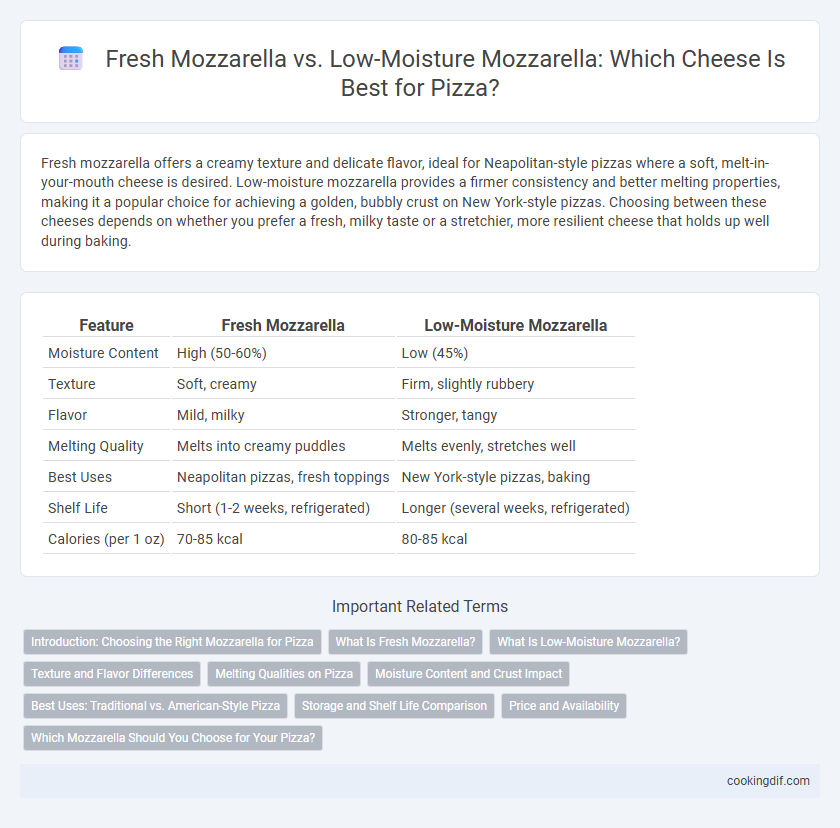Fresh mozzarella offers a creamy texture and delicate flavor, ideal for Neapolitan-style pizzas where a soft, melt-in-your-mouth cheese is desired. Low-moisture mozzarella provides a firmer consistency and better melting properties, making it a popular choice for achieving a golden, bubbly crust on New York-style pizzas. Choosing between these cheeses depends on whether you prefer a fresh, milky taste or a stretchier, more resilient cheese that holds up well during baking.
Table of Comparison
| Feature | Fresh Mozzarella | Low-Moisture Mozzarella |
|---|---|---|
| Moisture Content | High (50-60%) | Low (45%) |
| Texture | Soft, creamy | Firm, slightly rubbery |
| Flavor | Mild, milky | Stronger, tangy |
| Melting Quality | Melts into creamy puddles | Melts evenly, stretches well |
| Best Uses | Neapolitan pizzas, fresh toppings | New York-style pizzas, baking |
| Shelf Life | Short (1-2 weeks, refrigerated) | Longer (several weeks, refrigerated) |
| Calories (per 1 oz) | 70-85 kcal | 80-85 kcal |
Introduction: Choosing the Right Mozzarella for Pizza
Fresh mozzarella offers a creamy texture and high moisture content that melts smoothly, ideal for Neapolitan-style pizzas. Low-moisture mozzarella provides a firmer texture with less water, resulting in a stretchier melt and longer shelf life, preferred for New York-style pizzas. Selecting the right mozzarella depends on desired flavor, moisture level, and pizza style to achieve the perfect cheese balance.
What Is Fresh Mozzarella?
Fresh mozzarella is a soft, white cheese with high moisture content, traditionally made from buffalo or cow's milk, characterized by its delicate, milky flavor and smooth, elastic texture. Unlike low-moisture mozzarella, which is firmer and drier due to aging and moisture removal, fresh mozzarella melts beautifully on pizza, offering a creamy, gooey experience that enhances the overall taste. Its high moisture level makes it ideal for Neapolitan-style pizzas, providing a tender, slightly chewy texture and a fresh, mild flavor that contrasts with the robust toppings.
What Is Low-Moisture Mozzarella?
Low-moisture mozzarella is a dried, aged cheese with reduced water content, resulting in a firmer texture and longer shelf life compared to fresh mozzarella. It melts evenly, making it ideal for pizza toppings that require consistent browning and less moisture release during baking. This type of mozzarella is commonly used in commercial pizzerias for its durability and ability to create the classic stretchy cheese pull.
Texture and Flavor Differences
Fresh mozzarella offers a soft, creamy texture with a mild, slightly tangy flavor that melts smoothly, ideal for traditional Neapolitan-style pizzas. Low-moisture mozzarella has a denser, firmer texture and a more concentrated, salty taste, providing better stretch and browning when baked. Choosing between the two impacts the pizza's mouthfeel and overall flavor intensity, with fresh mozzarella delivering a delicate, fresh profile and low-moisture mozzarella enhancing meltability and savory depth.
Melting Qualities on Pizza
Fresh mozzarella offers a creamy texture with high moisture content, resulting in a smooth, melty consistency on pizza that creates a rich, authentic Italian flavor. Low-moisture mozzarella has less water, which allows it to melt evenly while producing a slightly firmer texture and a more pronounced stretch, ideal for achieving the classic gooey cheese pull. The choice between fresh and low-moisture mozzarella directly impacts the pizza's overall melt quality, texture, and flavor profile.
Moisture Content and Crust Impact
Fresh mozzarella contains a higher moisture content, typically around 50-60%, which results in a creamier texture and a moist, tender crust on pizza. Low-moisture mozzarella has about 40-45% moisture, offering a denser texture that melts evenly and creates a crispier, more golden crust. The choice between these cheeses significantly influences the pizza's overall mouthfeel and crust quality, with fresh mozzarella enhancing softness and low-moisture mozzarella providing a firmer, more structured base.
Best Uses: Traditional vs. American-Style Pizza
Fresh mozzarella offers a creamy texture and mild flavor ideal for traditional Neapolitan pizzas where melting quality and moisture enhance the crust's softness. Low-moisture mozzarella provides a firmer consistency and sharper taste, making it better suited for American-style pizzas that require longer baking times and a more stretchable cheese. Choosing between the two depends on desired pizza style, with fresh mozzarella emphasizing authenticity and low-moisture mozzarella supporting durability and browning.
Storage and Shelf Life Comparison
Fresh mozzarella contains a high moisture content, making it highly perishable and requiring refrigeration with a typical shelf life of about one week. Low-moisture mozzarella has reduced water content, allowing it to be stored longer, often lasting several weeks when refrigerated and even months if frozen. Choosing low-moisture mozzarella enhances storage flexibility and extends shelf stability, especially for bulk use or long-term supply.
Price and Availability
Fresh mozzarella offers a delicate, creamy texture but tends to have a higher price point and limited availability, often requiring refrigeration and quicker consumption. Low-moisture mozzarella is more affordable, widely available in most grocery stores, and boasts a longer shelf life, making it a popular choice for pizza production and commercial use. Both cheeses impact the melt quality and moisture level of the pizza but differ significantly in cost and distribution.
Which Mozzarella Should You Choose for Your Pizza?
Fresh mozzarella boasts a high moisture content, yielding a creamy texture and mild flavor that melts smoothly, ideal for Neapolitan-style pizzas with a soft, airy crust. Low-moisture mozzarella offers a firmer texture, longer shelf life, and a more concentrated, savory taste that creates a perfectly gooey, slightly browned topping, making it a favorite for New York-style pizzas. Choosing between fresh and low-moisture mozzarella depends on your desired pizza style and melting characteristics, balancing moisture level and flavor intensity.
Fresh mozzarella vs Low-moisture mozzarella for cheese type Infographic

 cookingdif.com
cookingdif.com